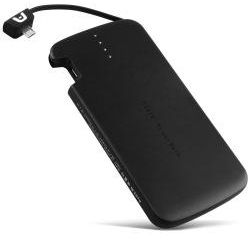Smartphones and the SAR Mission, Part I: Portable Power
 Thursday, April 25, 2013 at 14:33
Thursday, April 25, 2013 at 14:33  Jeff Lehman
Jeff Lehman For the past several years I have found a smartphone to be invaluable in my work as a SAR team member. It can function as a geo-tagging camera, notepad, inclinometer, compass, GPS, map, calculator, as well as a communication device. Anymore, unless the weather is very poor, I hardly use the GPS that sits in my pack. I wanted to take a few moments to share some of the Android applications and web services that I have found useful in discharging my SAR duties. I have previously mentioned tools to use your phone as a pager, but I will begin this series with extending your battery life.
One thing that is true of all smartphones is that they are extremely power hungry. It seems that getting through a single day of use is the goal of most manufacturers. Designing for larger batteries can make the svelte smartphone less desirable when carried all day. This doesn't help the rescuer as they are often called into duty at the end of their day. Having time to fully charge a phone prior to entering the field is often not an option. To complicate matters, many of the useful smartphone utilities are very power hungry, so the first order of business is to keep the phone running for extended periods of time.
Phones come in two principal categories. Those with removable batteries, and those without. The Apple iPhone is the most popular phone without a user-removable battery, but there are a number of others such as Google's Nexus 4. With these types of phones, the only choice is an external battery. For those phones with user-removable batteries, the solution may be as simple as purchasing additional batteries, or, if available, purchasing a higher capacity battery. The advantage of purchasing additional batteries is that all of your cases, and other accessories will still work. Purchasing a high-capacity battery will probably require a modified phone back, which may also require a new case or other carrying accessory, but you probably won't have to swap batteries as often. Most popular phones have high capacity user-swappable batteries available.
 iAnker AstroSlim 2Sure, having a cigarette lighter charger is a good idea, but it doesn't do so well when you are hiking through the wilderness. Fortunately, there are a host of external batteries available for devices without a user-removable battery. External batteries come in a variety of capacities, and a variety of form factors. My current favorites are those from iAnker. These batteries are flat, and pocket friendly. The killer feature on many of them is an integrated cable to charge your phone. The non-Apple world has standardized on the micro USB connector as a charging standard, so that has been a boon for external charger manufacturers. Gone are the annoying days of a different charging connector for every brand and model. Just about all external batteries come with a full-size USB port, so with the appropriate cable, any USB device can be charged.
iAnker AstroSlim 2Sure, having a cigarette lighter charger is a good idea, but it doesn't do so well when you are hiking through the wilderness. Fortunately, there are a host of external batteries available for devices without a user-removable battery. External batteries come in a variety of capacities, and a variety of form factors. My current favorites are those from iAnker. These batteries are flat, and pocket friendly. The killer feature on many of them is an integrated cable to charge your phone. The non-Apple world has standardized on the micro USB connector as a charging standard, so that has been a boon for external charger manufacturers. Gone are the annoying days of a different charging connector for every brand and model. Just about all external batteries come with a full-size USB port, so with the appropriate cable, any USB device can be charged.
Mophie Juice PackWhile the iPhone can be charged with just about any external battery, there are a few interesting extended battery solutions just for Apple's iOS device. Probably the most interesting is the Mophie Juice Pack. The ingenious Juice Pack integrates a case and battery. No fumbling with cables, and the phone is protected by a case. This is great for SAR work. The Juice Pack is also available for a few, popular non-iOS devices as well.
Many of these external batteries charge via USB, but some come with their own walwart charger, or the walwart is integrated into the device. There are a number of capacities available. For example, iAnker offers external batteries from 2600mAH to 13000 mAH in capacity. The "typical" cell phone battery has a capacity of approximately 2000 mAH, so the AstroSlim 2, pictured above, with a capacity of 4500 mAH, should provide about 2 recharges to the typical cell phone battery. Sure, a higher capacity will provide more use time, but a higher capacity battery also weighs more and has a larger volume. The 4500 mAH iAnker battery is about the size of your typical smartphone.
Other external batteries that you may also check out are those from NewTrent and the Zagg Sparq. These have integrated chargers which make them a bit larger, but they are also easily charged from any wall outlet.
Now that your phone can stay powered for an entire operational period, it is now time to load up a few useful apps and take it into the field for some SAR action. The next part of this series will explore a number of navigation applications.
 battery,
battery,  smartphone in
smartphone in  News
News 
Reader Comments